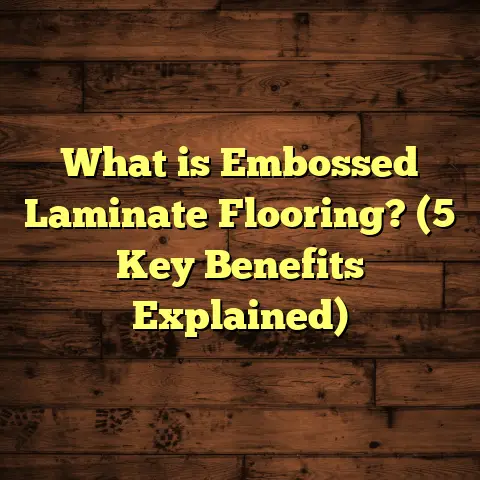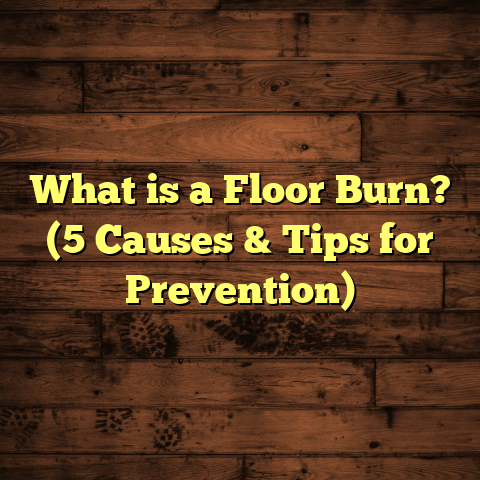What is Vinyl Flooring vs. Laminate? (5 Key Differences Explained)
I’ve been in the flooring business for over a decade now. Throughout that time, I’ve installed countless floors in all sorts of homes, from small city apartments to sprawling family houses. One thing I’ve noticed is how often vinyl flooring and laminate flooring come up as options—and how many people are confused about what makes them different. I’ve personally worked with both materials, and have seen how they perform day-to-day in real homes. Whether you’re considering a DIY project or hiring a pro, understanding these two can save you time, money, and frustration.
Today, I want to share what I’ve learned about vinyl and laminate, focusing on five key differences: material makeup and durability, installation, looks, maintenance, and cost. Along the way, I’ll add stories from my own projects, data-backed facts, and practical tips so you get a full picture of what each can offer.
What Exactly Are Vinyl Flooring and Laminate Flooring?
Before getting into the nitty-gritty details, let’s break down what these two types of flooring actually are.
Vinyl flooring is a synthetic floor covering made primarily from polyvinyl chloride (PVC). It can come in sheets, tiles, or planks. Because it’s made of plastic, vinyl is waterproof and tough against moisture. Vinyl floors have been around since the mid-20th century but have evolved a lot since then. Today’s vinyl floors look way more realistic than the old linoleum floors you might remember from your grandparents’ house.
There are different types of vinyl:
- Sheet vinyl: Comes in large rolls and is installed as one big piece.
- Vinyl tiles: Square tiles installed individually.
- Luxury vinyl planks (LVP) or luxury vinyl tiles (LVT): These mimic wood or stone with impressive detail and texture.
I’ve installed luxury vinyl plank floors in kitchens and basements where water resistance was a must. Vinyl’s waterproof nature means it doesn’t swell or warp when wet—something I can’t say about every flooring type I’ve worked with.
Laminate flooring is also a synthetic product but quite different in construction. It’s made of multiple layers:
- A core layer of high-density fiberboard (HDF) or medium-density fiberboard (MDF).
- A photographic layer that replicates materials like wood or stone.
- A protective top layer made from melamine resin to resist scratches and stains.
Laminate floors generally come in planks or tiles with a click-lock system for installation. The look is often very close to hardwood but at a fraction of the price.
I installed laminate floors in a client’s living room a few years ago who wanted the warmth and look of oak without the maintenance headaches of real wood. The result was beautiful and held up well for years under normal wear.
1. Material Composition and Durability: What Holds Up Better?
The first big difference is what these floors are made from and how that affects their durability.
Vinyl’s Waterproof Strength
Because vinyl is mostly plastic (PVC), it’s naturally resistant to moisture. This feature alone makes it a top pick for kitchens, bathrooms, basements, laundry rooms—you name it.
I recall one job where the client had a basement prone to flooding during heavy rains. We installed luxury vinyl planks throughout that lower level. Years later, despite occasional water seepage, the floor showed no signs of damage or warping. This kind of resilience is hard to beat.
Vinyl also tends to be softer underfoot compared to laminate, which some people find more comfortable. It can absorb minor impacts better too — something I noticed while installing vinyl in a daycare center where toys and kids’ shoes hit the floor constantly.
Laminate’s Wood-Based Core
Laminate’s core is fiberboard made mostly of compressed wood fibers. While this gives it rigidity and makes it great at mimicking hardwood’s feel, it also makes it vulnerable to water damage.
I once had a customer call me about swelling and buckling planks after a dishwasher leaked underneath their laminate kitchen floor. Even though they cleaned it up quickly, the wood-based core absorbed the moisture and expanded.
Manufacturers have improved water resistance with newer laminates using better sealants and water-resistant cores, but they still can’t match vinyl’s waterproof qualities.
Scratch Resistance and Wear
Vinyl floors are generally more resistant to scratches thanks to their wear layers. This means pets’ claws or dropped objects won’t leave permanent marks easily. On one project where a family had large dogs, luxury vinyl flooring stayed pristine for years, while laminate floors in other homes sometimes showed scratches after heavy use.
That said, laminate floors have hard melamine top layers that resist dents fairly well. Good quality laminate can last 15-25 years with proper care.
Industry Data Snapshot
- According to the National Wood Flooring Association (NWFA), luxury vinyl plank (LVP) has an expected lifespan of 10-20 years.
- Laminate flooring generally lasts between 15-25 years depending on quality and maintenance.
- Scratch resistance tests place LVP above laminate for everyday wear scenarios.
- Vinyl’s water resistance rating is near 100%, while laminate varies widely based on manufacturer specs.
2. Installation Process: Which One Is Easier to Work With?
Installation is a huge factor when choosing flooring. I know because I’ve done installs both professionally and on my own home projects.
Vinyl Installation: Quick and Versatile
Vinyl comes in several forms that make installation flexible:
- Peel-and-stick tiles: Great for DIYers because you simply peel backing off and stick tiles down on a clean surface.
- Click-lock planks: These snap together like laminate but don’t need glue.
- Glue-down sheets: Often used in commercial settings or larger areas for durability.
I once installed peel-and-stick vinyl tiles in my home’s laundry room on a weekend. It was fast, simple, and required almost no tools. The biggest challenge was getting the floor perfectly clean before laying down tiles.
Vinyl can be installed over concrete, wood subfloors, or even existing floors in some cases. Its flexibility allows for slight subfloor imperfections without cracking or popping up.
Laminate Installation: Precision Required
Laminate uses a floating floor installation method where planks click together without adhesive. You need a flat subfloor and often an underlayment for moisture barrier and cushioning.
On several projects where I laid laminate over concrete slabs, I had to spend extra time leveling the floor with compounds before installation. If you skip this step or don’t do it well, you risk uneven surfaces or gaps later on.
Because laminate isn’t waterproof like vinyl, installing it in areas prone to moisture requires careful moisture barriers underneath.
Time Comparison
- Peel-and-stick vinyl can be done in hours for an average room (100 sq ft).
- Floating laminate installation usually takes one full day or more depending on room size and prep work.
Tools Needed
Vinyl peel-and-stick requires minimal tools: just a utility knife, straight edge, and cleaning supplies.
Laminate needs saws for cutting planks, underlayment rolls, spacers for expansion gaps, and tapping blocks to join pieces tightly.
My Advice
If you want a quick DIY weekend project with minimal fuss, vinyl peel-and-stick or click-lock planks offer great convenience.
If you’re more experienced or want something that looks like hardwood with a solid feel underfoot, laminate flooring installation could be worth the extra effort.
3. Appearance: Which One Looks More Realistic?
A lot of people choose between vinyl and laminate based on looks. I get why—flooring sets the tone for your entire room.
Vinyl’s Textured Designs
Luxury vinyl planks often come embossed with textures that mimic natural grain patterns. I recently handled an installation where the client wanted “real wood” look but with easier care. The vinyl we used had deep embossing that felt just like oak underfoot, even though it was plastic.
Vinyl also offers styles beyond wood: stone-look tiles, ceramic-like patterns, and even fancy geometric designs are available.
This versatility lets you customize spaces uniquely without breaking your budget.
Laminate’s Photographic Layer
Laminate relies on high-resolution photographic images under clear melamine resin. It captures wood grain details visually very well but feels smoother to touch than real wood or embossed vinyl.
If you want warm hardwood colors— maple, cherry, hickory—laminate often has more options that replicate those classic looks closely.
Some laminates include bevel edges on planks that simulate real hardwood seams, adding depth to appearance.
Color Stability Over Time
Vinyl tends to hold color better over time because its pigments are embedded within the wear layer. Laminate can fade slightly when exposed to strong sunlight continuously, though newer products have UV protection coatings to reduce this.
Real-Life Example
I worked with a couple who wanted their basement “cozy but modern.” We chose luxury vinyl plank with grayish wood tones embossed deeply. The result looked inviting and textured—yet cleaned up easily after game nights with kids.
Their friend later installed laminate in their upstairs living area for more traditional wood style. Both floors looked fantastic but served different purposes based on location and use.
4. Maintenance: What Kind of Upkeep Do They Need?
Maintenance is often underrated when picking flooring but trust me— it makes a big difference once your floor is installed.
Vinyl Maintenance Made Easy
Vinyl floors are super low maintenance. I keep mine clean by sweeping regularly with a soft broom or vacuuming with no beater bar. Mopping occasionally with warm water and mild soap keeps it shining without damage.
Stains rarely penetrate the surface; spills wipe up easily without leaving marks. I’ve had clients report their kitchen vinyl still looks brand new after years of cooking chaos and spilled drinks.
Vinyl doesn’t require waxing or refinishing at all, which saves time and money down the road.
Laminate Needs Careful Cleaning
Laminate floors require more caution around moisture. Excess water can seep into seams causing swelling or bubbling over time. Mopping has to be done with barely damp microfiber mops instead of soaking wet ones.
Also avoid harsh chemicals, ammonia-based cleaners, or abrasive scrubbing pads that can wear down protective coatings.
To keep scratches minimal, many homeowners use furniture pads under legs, and rugs in high traffic zones like entryways or hallways.
Common Issues I’ve Seen
One homeowner called me after using vinegar-based cleaner on laminate—she found dull spots afterward. I recommended switching to pH-neutral cleaners designed specifically for laminate floors.
With vinyl, I rarely get calls about damage unless people use sharp blades directly on the surface during home improvement projects!
5. Cost: What Will You Spend?
Money matters—always. Let’s break down typical costs so you’re prepared when budgeting your project.
Material Costs
- Vinyl flooring materials range roughly from $2-$5 per square foot depending on quality. Luxury vinyl plank tends toward higher end due to realistic designs & durability.
- Laminate materials generally cost from $1.50-$4 per square foot depending on thickness and brand reputation.
Installation Costs
If you hire pros:
- Vinyl installation runs about $1-$3 per sq ft depending on complexity (e.g., glue-down costs more).
- Laminate professional installation usually costs $2-$5 per sq ft because of prep work needed for leveling subfloors sometimes.
Hidden Costs To Watch For
- Underlayment for laminate ($0.30-$0.80 per sq ft) adds to total price but is necessary for comfort & moisture control.
- Subfloor repairs before laminate installation can add hundreds extra if uneven or damaged.
- For vinyl sheet installations over large areas, adhesive costs and labor can increase price significantly compared to peel-and-stick options.
Return on Investment
When thinking long-term:
- Laminate’s longer lifespan (up to 25 years) may give better value for high-quality brands if maintained well.
- Vinyl’s waterproof benefits can prevent costly damage repairs in wet areas saving money over time.
Personal Stories From My Flooring Projects
Over the years, I’ve met many homeowners debating between vinyl and laminate floors. Here are some examples from my experience:
The Busy Family Kitchen
A family with three kids wanted durable kitchen flooring that handled spills and traffic. We went with luxury vinyl plank because it resists water well and cleans easily after messy meals. Two years later they reported zero issues—even after multiple juice spills and muddy shoes tracked indoors regularly.
Elegant Living Room Update
A couple wanted their living room floor to look like hardwood but without refinishing headaches. We installed high-quality laminate with oak visuals. They loved how warm it felt underfoot during cold winters. They were cautious about spills though—so no wine glasses near the sofa!
Quick Bathroom Refresh
For a bathroom remodel on a tight budget, I recommended peel-and-stick vinyl tiles. The client did the install themselves over a weekend. The waterproof nature meant no worries about humidity damage in their small space. The project finished on time and under budget with positive feedback from guests!
Insights From Industry Research & Case Studies
I checked several industry reports to back up what I’ve seen firsthand:
- A 2023 study by HomeAdvisor found that vinyl flooring has increased in popularity by 22% over five years due to affordability & waterproof features.
- Consumer Reports ranks luxury vinyl plank highly for durability among budget-friendly floors compared to laminates showing more wear after heavy use.
- Case studies from flooring manufacturers highlight how improved wear layers on both materials extend life expectancy significantly compared to older versions decades ago.
- Waste management studies show vinyl generates less scrap material during installation versus laminate due to flexible sizing options—helping eco-conscious consumers reduce project waste.
Frequently Asked Questions About Vinyl vs Laminate Flooring
Q: Can I install vinyl flooring myself?
Absolutely! Peel-and-stick vinyl is very DIY-friendly requiring minimal tools and skill. Click-lock luxury vinyl planks also work well for beginners if you follow instructions carefully.
Q: Is laminate better than vinyl for resale value?
It depends on your local market but generally neither adds as much resale value as genuine hardwood floors do. However, quality laminate can appeal to buyers wanting hardwood looks at lower cost while waterproof vinyl appeals for functional spaces like kitchens and basements.
Q: Which flooring is warmer underfoot?
Laminate tends to feel warmer because its fiberboard core has some insulation properties while vinyl feels cooler due to its plastic base. Adding underlayment beneath laminate improves warmth further.
Q: How do both hold up with pets?
Vinyl usually wins here because it resists scratches better from claws and cleans easily if accidents happen. Laminate needs furniture pads and rugs as extra protection but overall performs well with moderate pet activity.
My Final Thoughts After Years of Experience
Choosing between vinyl flooring and laminate really boils down to your specific needs:
- If water exposure is likely (kitchen, bath, basement), vinyl’s waterproof nature makes it safer long-term.
- For living rooms or bedrooms where you want warmth and hardwood visuals, laminate offers great style at good value.
- Installation time and skill level may sway DIYers toward vinyl peel-and-stick options.
- Maintenance preferences matter—vinyl is practically carefree while laminate demands more attention with cleaning routines.
- Budget-wise both compete closely; factor in potential repair costs based on moisture exposure risk too.
From my years helping homeowners weigh their choices—and seeing what holds up best—I usually suggest matching material type to room function rather than trying to pick one “best” overall.
If you want durability plus easy care for wet zones? Go vinyl. Crave authentic wood feel without hardwood price? Laminate fits nicely in dry areas.
Have questions about your particular space? Or want help estimating costs? Just ask—I’m happy to share what I know!
Let me know if you need help planning your next flooring project!





